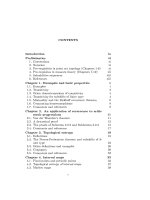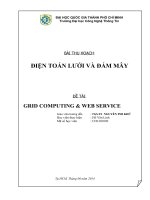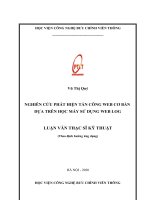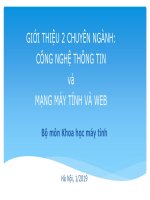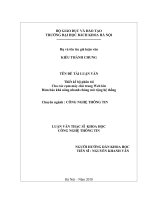May 2023 qas (web version)
Bạn đang xem bản rút gọn của tài liệu. Xem và tải ngay bản đầy đủ của tài liệu tại đây (3.25 MB, 45 trang )
SECTION 1: READING
The passage indicates that parts of the journey
from Naples to Buenos Aires have been
A. hazardous.
B. tedious.
C. disheartening.
D. perplexing.
As used in line 12, “wove” most nearly means
A. intermingled.
B. formed.
C. invented.
D. folded.
Based on the passage, which statement best
describes Leda’s attitude about moving to
Argentina?
The passage most strongly suggests that
Leda’s distant view of the buildings on the
Argentinian coast
A. Leda longs to arrive in her new country even though she has
little concept of what awaits her.
A. awakens her excitement at having finally fulfilled her dream to
travel abroad.
B. Leda looks forward to starting a new life with Dante even
though she will miss her family.
B. reinforces her sense of her ignorance about the realities of her
new life.
C. Leda is initially curious about living abroad but becomes
nervous after leaving her homeland.
C. ignites her determination to help her husband improve his
business.
D. Leda is uncertain about moving but feels reassured after
seeing Dante’s photograph.
D. underscores her disappointment with the urban location of
her new home.
Which choice best supports the idea that the
photograph of Dante prompts Leda to consider his
mindset?
A. line 17-19 (“Over . . . home”)
B. line 19-20 (“It had . . . bemusement”)
C. line 29-31 (“No fighting . . . see”)
D. line 34-35 (“Dante’s . . . say”)
According to the passage, the accounts often
told about the Américas are
A. healing, because the accounts promise comfort to travelers
escaping hardships.
B. instructive, because the accounts provide travelers with
suggestions for how to succeed.
C. misleading, because the accounts present travelers with a
portrayal that is not necessarily accurate.
D. discouraging, because the accounts suggest the degree of
adjustment facing travelers may be greater than they
anticipated.
As used in line 37, “glowed” most nearly means
B. remained vivid.
It can reasonably be inferred from the passage
that for Leda, the garden in the photograph mainly
represents
C. provided light.
A. a reassuring daydream in the face of an uncertain future.
D. gained intensity.
B. a revealing indication of the amenities commonly found in
Buenos Aires.
A. radiated heat.
The phrase in parentheses in line 43-44 (“as it . .
. minds”) mainly serves to
A. emphasize the similarities between Leda’s initial impressions
of Argentina and those of the other passengers.
C. an unexpected confirmation that her hopes for her new life
will be fulfilled.
D. an impressive sign of her husband’s achievements in
Argentina.
B. convey the passengers’ growing confidence in what the future
holds for them.
Which choice provides the best evidence for the
answer to the previous question?
C. highlight that Argentina represents something unique to each
passenger.
A. line 32-34 (“In it . . . alive”)
D. note that Leda feels disconnected from the other passengers
despite being surrounded by them.
B. line 35-36 (“Of course . . . way”)
C. line 36-37 (“She knew . . . mind”)
D. line 52-55 (“Leda . . . swan”)
Figures adapted from Jessie Sun et al., “The Language of Well-Being: Tracking Fluctuations in Emotion
Experience through Everyday Speech.” ©2019 by American Psychological Association.
The main purpose of the passage is to
A. present findings that weaken the popular theory that social
media usage alters individuals’ emotional vocabularies.
B. summarize an experiment intended to investigate a
hypothesis about how language usage affects emotional states.
C. describe research that challenges an assumption underlying
studies about the relationship between language and emotions.
D. discuss a study that incorporates the use of some novel tools
developed for the study of emotionally charged language.
One important function of the quotation from
Sun’s team’s study in line 24-26 (“Our . . . language”)
is to
A. suggest how the study’s conclusions could influence the
design of future studies.
B. acknowledge that additional research may be needed to
validate the team’s findings.
C. emphasize that the study qualifies rather than overturns a
controversial view.
D. rule out a potential criticism of how the study was carried out.
Based on the passage, which finding, if true,
would most strongly support the reliability of the
method used by Sun’s team?
A. People tend to explicitly describe their emotional states less
frequently than every 9.5 minutes.
B. People tend to retain fairly accurate memories of their
emotional states for several hours after experiencing them.
Based on the passage, Sun’s team would most
likely agree that one limitation of using
transcriptions of speech to evaluate speakers’
emotions is that
C. People tend to report positive emotional states as being of
greater duration than are negative emotional states.
A. transcriptions are prone to erroneous representations of
speakers’ word choices.
D. People tend to be more accurate when evaluating friends’
emotional states than when evaluating strangers’ emotional
states.
B. most of the words in a transcription will typically not be
emotionally positive or negative.
Which choice provides the best evidence for the
answer to the previous question?
C. information about speakers’ emotions can be conveyed in
ways that transcriptions do not represent.
D. transcribed speech from speakers in highly emotional states
tends to be difficult for readers to comprehend.
A. line 5-7 (“The premise . . . emotions”)
B. line 7-8 (“But . . . hold up”)
C. line 11-12 (“Sun’s . . . minutes”)
D. line 12-14 (“Four . . . hour”)
A student raises the possibility that a single clip
containing an unusually high number of emotional
words could have a disproportionate influence on
Sun’s team’s measurement of that participant’s
emotional word use. Which choice best supports the
idea that Sun’s team accounted for this possibility in
the design of the study?
A. line 15-16 (“The team . . . words”)
B. line 16-19 (“They . . . topics”)
C. line 19-22 (“Finally . . . mood”)
D. line 23-24 (“The researchers . . . mood”)
According to the passage, Sun’s team found
that the associations they detected between
emotional states and certain groups of
nonemotional words were
A. not strong enough to simply treat those groups of words as
reliable indicators of emotional states.
B. not widespread enough to exclude the possibility that only a
subgroup of individuals uses those words in emotional ways.
C. so weak that emotional words are a preferable measure of
speakers’ emotions.
D. so surprising that the team suspects that they may have
made errors in transcribing those words.
A. controlled.
According to figure 2, when the change in
human raters’ assessment of speakers’ emotional
state was 1, the average self-reported amount of
positive emotion was approximately
B. recorded.
A. 1.8.
C. conquered.
B. 2.5.
D. attracted.
C. 3.
As used in line 39, “captured” most nearly
means
D. 4.
Information in the passage most strongly
suggests that the results shown in figure 1 might be
due in part to
Both figures support which statement about
participants in the study, on average?
A. human raters detecting changes in participants’ emotional
states based on factors such as intonation and volume.
A. They reported greater amounts of positive emotion than
negative emotion.
B. participants unconsciously altering their word choices as a
result of knowing that their speech would be analyzed.
B. They used more positive emotion words than negative
emotion words.
C. the classification of some words as positive or negative not
accurately indicating how participants used those words.
C. They experienced little change in emotional state over the
course of the day.
D. words related to socializing being more likely to be classified
as positive emotion words than as negative emotion words.
D. They showed a decline in the frequency of positive emotion
words as human raters’ assessment of their emotional state
increased.
Figures adapted from Sara Mazrouei et al., “Earth and Moon Impact Flux Increased at the End of the Paleozoic.” ©2019 by American
Association for the Advancement of Science.
Based on the passage, the team believed that
their use of crater data from the Moon to draw
conclusions about Earth was justified in part
because
A. the rate of cratering on the Moon appears to have changed
little over time.
B. similar numbers of craters have been preserved on the Moon
and on Earth.
C. the probability of the Moon encountering impactors is
approximately the same as that for the Earth.
D. Earth’s atmosphere deflects or destroys a high proportion of
potential impactors.
Which choice provides the best evidence for the
answer to the previous question?
A. line 3-4 (“So to . . . Moon”)
B. line 5-7 (“We can . . . Toronto”)
C. line 8-9 (“With . . . craters”)
D. line 9-10 (“If the . . . argue”)
In context, the sentence in line 10-12 (“But
without . . . bursts”) mainly serves to
A. identify a problem that the team would need to solve before
they could proceed with their study.
B. explain why the team would not be able to draw conclusions
about Earth from features on the Moon.
C. summarize the consensus understanding of lunar cratering
that the team challenged.
D. acknowledge that existing lunar maps appeared to contradict
the team’s hypothesis.
As used in line 11, “suffered” most nearly
means
A. were disadvantaged by.
B. were subjected to.
C. had resisted.
D. had deteriorated under.
As used in line 17, “popping out” most nearly
means
A. becoming apparent.
B. expanding upward.
C. exiting forcefully.
D. moving rapidly.
Based on the passage, the team trusts the
results of the nighttime glow method, in part,
because they also believe which of the following is
true?
A. Lunar craters less than 10 kilometers in diameter have
insufficient debris nearby to reliably determine their ages.
B. An absence of large rocks around a lunar crater can be
explained by factors other than the crater’s age.
C. The ages of some lunar craters could be reliably determined
before the nighttime glow method was developed.
D. Craters on the Moon that were created early in its history have
been almost entirely erased by subsequent bombardments.
Which choice provides the best evidence for the
answer to the previous question?
A. line 17-19 (“Older . . . night”)
B. line 20-21 (“Ghent . . . age”)
C. line 21-23 (“Then . . . rate”)
D. line 24-25 (“Most . . . constant”)
The main purpose of the eleventh paragraph
(line 37-40) is to
A. propose a future application of the team’s methods.
B. rebut a possible criticism of the team’s conclusions.
C. explain an apparent anomaly in the team’s data.
D. preclude a potential unwarranted inference from the team’s
results.
According to figure 1, among the youngest 50%
of lunar craters greater than 20 kilometers in
diameter, the oldest that a crater could be is between
A. 200 and 300 million years old.
B. 300 and 400 million years old.
C. 400 and 500 million years old.
D. 500 and 600 million years old.
According to figure 2, among Earth’s craters
greater than 20 kilometers in diameter, the
percentage that are younger than 550 million years
old is closest to
A. 80%.
B. 70%.
C. 60%.
D. 50%.
Taken together, the figures best support which
statement about craters greater than 20 kilometers
in diameter on the Earth and the Moon?
A. The number of such craters is greater on the Earth than it is
on the Moon.
B. The percentage of such craters under 100 million years old is
greater on the Moon than on the Earth.
C. The Earth experienced a longer period with no change in the
percentage of such craters than the Moon did.
D. The percentage of such craters that are younger than 250
million years old is greater on the Earth than on the Moon.
Throughout the passage, Olmsted develops
which claim about natural spaces?
Olmsted’s use of similar phrases containing
“and yet” (line 18) mainly serves to
A. Private landowners are better equipped financially to maintain
preserved spaces than government is.
A. emphasize the problems caused by conflicting opinions about
property ownership.
B. Government should play a more prominent role in protecting
natural parks from overuse by the public.
B. debunk the apparent contradiction of preserving the
wilderness while opening it up for public use.
C. Increased access to undeveloped nature is needed to improve
the well-being of a nation’s citizens.
C. convey the paradoxical quality of the effect that gazing at
natural beauty has on human beings.
D. Keeping a significant percentage of land in its natural state
connects people to a nation’s agrarian past.
D. promote the utility of spending time in nature for both
recreational and educational purposes.
Which choice best supports the idea that
Olmsted believes that many activities people find
gratifying are also burdened with obligations?
Based on the passage, Olmsted would most
likely agree with which claim about the very wealthy
of his time?
A. line 7 (“In the interest . . . this”)
A. They are traditionally reluctant to purchase and invest in
natural lands that offer little financial gain in return.
B. line 8-10 (“The attention . . . end”)
C. line 10-12 (“There . . . mixed”)
D. line 13-15 (“In all . . . mingles”)
B. They often turn to natural scenery when the stress caused by
financial burdens becomes overwhelming.
C. They have shown that sharing their private natural lands with
the common people provides benefits to the entire society.
D. They accumulate private property because they derive the
same benefit from nature that the less wealthy do.
In the passage, Olmsted indicates that the
human tendency to seek out expanses of nature
Which choice provides the best evidence for the
answer to the previous question?
A. is the cause of a recent fashion trend popular among the
wealthy.
A. line 22-25 (“They . . . present”)
B. line 26-30 (“The value . . . population”)
B. reinforces the belief that recreational pursuits should be
financed by the aristocracy.
C. line 37-39 (“Thus . . . people”)
C. is an enduring trait, as proved by historical precedents.
D. line 39-42 (“For the . . . government”)
D. inspires a collective unity, since landowners must support
communal interests.
As used in line 24, “retreats” most nearly means
A. havens.
B. withdrawals.
C. concealments.
D.evasions.
The passage most strongly implies that Olmsted believes
private parks have historically
A. improved the general physical health of the population
regardless of who used them.
B. consumed more financial resources than can be justified by
their relative benefit to society.
C. developed an increasingly sophisticated and luxurious style
over the centuries.
D. enabled the relaxation of social hierarchies when they
became open to the public.
As used in line 29, “extend” most nearly means
A. offer.
B. increase.
C. protrude.
D. enlarge.
Olmsted’s repetition of the word “very” (line 32)
mainly serves to
A. convey his surprise about the emergence of an unusual land
distribution pattern.
B. underscore his opinion that the wealthy have an eccentric
attitude regarding nature parks.
C. reinforce the common belief that nature is most accessible in
rural areas.
D. emphasize that access to scenic areas has become an
exclusive privilege.
Over the course of Passage 1, the main focus
shifts from
A. an explanation of a process to a discussion of research aimed
at exploring how global temperature increases may affect that
process.
B. a hypothesis about how global temperatures drive a process
to a study designed to test that hypothesis.
C. a presentation of two sides of a debate about the effects of
global temperature on a process to a summary of evidence in
support of one side of that debate.
D. a review of previous research regarding the gradual
development of a process to a consideration of the future
implications of sudden changes to that process.
Which choice from Passage 1 best supports the
idea that certain organisms cannot survive in
extreme environmental conditions?
A. line 2-4 (“Dirt . . . detritus”)
B. line 4-6 (“Hungry . . . breath”)
C. line 11-13 (“Previous . . . completely”)
D. line 13-14 (“But . . . now”)
Passage 1 indicates that the balance observed
in the typical relationship between soil respiration
and photosynthesis
A. increases the amount of carbon dioxide that is released into
the air.
B. depends primarily on the number of microbes that survive in
soil.
C. is necessary to stabilize sudden instances of dangerously
severe weather patterns.
D. has been disrupted by an overall rise in global temperatures.
The first paragraph of Passage 2 (line 30-35)
mainly serves to
A. acknowledge an important discovery that will be
contextualized in the passage.
B. summarize an assumption that will be elaborated on in the
passage.
C. discuss the conclusions of a study that will be analyzed in the
passage.
D. emphasize a lack of consensus that will be ultimately
reconciled in the passage.
Which choice best states the relationship
between the passages?
A. Passage 2 underscores the importance of the research
conducted in Passage 1.
B. Passage 2 echoes a concern put forth by the researchers
featured in Passage 1.
C. Passage 2 offers an alternative explanation for the findings
presented in Passage 1.
D. Passage 2 raises doubts about the accuracy of the
conclusions described in Passage 1.
It can reasonably be inferred from Passage 2
that its author considers the “2,000 sources across
several ecosystems” noted in line 19, Passage 1 to
A. demonstrate a clear point of comparison between local and
global data.
B. provide evidence that has been later proved by scientists to be
unreliable.
C. represent a major advance over all previous studies of soil
respiration.
D. reflect different experimental approaches that are not
necessarily consistent with one another.
Which choice from Passage 2 provides the best
evidence for the answer to the previous question?
As used in line 34, “observed” most nearly
means
A. remembered.
B. preserved.
A. line 36-37 (“There . . . co-workers”)
B. line 39-40 (“This . . . studies”)
C. line 40-43 (“Moreover . . . calculations”)
D. line 50-51 (“Despite . . . carbon”)
C. attended.
D. detected.
The author of Passage 1 would likely consider
the statement in line 34-35, Passage 2 (“The authors
. . . change”) to be
As used in line 41, “translate” most nearly
means
A. an accurate summary of Bond-Lamberty and colleagues’
conclusions regarding an environmental process.
A. convert.
B. define.
C. explain.
D. reword.
B. a logical interpretation of Bond-Lamberty and colleagues’
analysis of microbial life spans.
C. a general reflection of Bond-Lamberty and colleagues’
investigation concerning carbon storage.
D. an objective review of Bond-Lamberty and colleagues’
research into atmospheric conditions.
SECTION 2: WRITING
Adapted from Ulf Büntgen and Nicola Di Cosmo, “Climatic and
Environmental Aspects of the Mongol Withdrawal from Hungary in
1242 CE.” ©2016 by Ulf Büntgen and Nicola Di Cosmo.
A. NO CHANGE
A. NO CHANGE
B. nevertheless,
B. quick and mobile
C. but
C. speedy and zippy
D. DELETE the underlined portion.
D. super fast and nimble
A. NO CHANGE
B. presents
C. have presented
D. are presenting
A. NO CHANGE
B. plain
C. compliant
D. modest
A. NO CHANGE
B. For example,
C. Be that as it may,
D. Therefore,
A. NO CHANGE
B. coordinated for
C. correlated in
D. coexisted at
The writer wants to add the following sentence
to the paragraph.
Which choice most accurately represents the
data in the graph?
While these explanations may hold some truth, one
factor likely played a larger role in the Mongol retreat
than has previously been recognized: the weather.
A. NO CHANGE
The best placement for the sentence is
A. after sentence 1.
B. after sentence 2.
C. after sentence 3.
D. after sentence 4.
B. below-average temperatures
C. average temperatures
D. no changes in temperature
D. an impressive sign of her husband’s achievements in
Argentina.
Which choice provides accurate information
from the graph?
A. NO CHANGE
B. In 1239,
C. In 1240,
D. After 1241
A.
NO CHANGE
B.
analysis shows, how
C.
analysis, shows how:
D.
analysis shows how
A.
NO CHANGE
B.
theories, but it
C.
theories, and it
D.
theories, it
Which choice most effectively sets up the main
discussion in the paragraph?
A. NO CHANGE
B. are kept in museums where they can be seen by countless
visitors.
C. are considered cultural touchstones and are studied by
scholars and historians.
A. NO CHANGE
B. these artists,
C. these characteristics,
D. these artworks,
D. were housed in private collections before being displayed
publicly.
A. NO CHANGE
A. NO CHANGE
B. because they utilize
B. concepts, such as the ephemeral and cyclical nature of life
C. by utilizing
C. concepts, such as the ephemeral and cyclical nature, of life,
D. will utilize
D. concepts such as the ephemeral and cyclical nature of life
A. NO CHANGE
B. outrageously
C. provocatively
D. exasperatingly
The writer wants to add the following sentence
to this paragraph.
These ice sculptures are left to melt and are meant
to contrast with the permanence of the monuments
on which they are placed.
The best placement for the sentence is
A. before sentence 1.
B. after sentence 1.
The writer is considering deleting the underlined
sentence. Should the sentence be kept or deleted?
A. Kept, because it provides relevant details about Ono’s
aesthetic choices in designing Apple.
C. after sentence 2.
D. after sentence 3.
B. Kept, because it clarifies the symbolic significance of the
apple in Ono’s body of work.
C. Deleted, because it provides a detail about Apple’s
composition that is unrelated to the paragraph’s main focus.
D. Deleted, because it unnecessarily repeats information about
the exhibition of Apple that is stated earlier.
Which choice most effectively combines the
sentences at the underlined portion?
A. the actual physical processes that works of art undergo can
be key to their impact.
B. when works of art undergo actual physical processes, those
processes can be key to their impact.
A. NO CHANGE
B. 2015,
C. works of art have impacts, and actual physical processes are
key to them.
D. the key to their impact, for works of art, can be the actual
physical processes that they undergo.
C. 2015;
D. 2015, saying
Which choice provides the most effective
conclusion to the passage?
A. NO CHANGE
A. NO CHANGE
B. begins
C. would have begun
D. began
B. will live on in the minds of viewers long after the physical
artifacts created by the artists are gone.
C. demonstrate that there is no single, monolithic vision of an
effective artistic practice.
D. show that the significance of a work of art can derive from
many factors, including how it was made and how many people
get to observe it.
A. NO CHANGE
B. monotonous
C. dim
D. weak
Which choice most effectively combines the
sentences at the underlined portion?
A. this interest, and she and Ford put the tool to use in studying
B. it, and she and Ford put the tool to use in studying
C. this interest that she described; using the tool, she and Ford
studied
D. the interest that she had, so afterward she and Ford used it to
study
A. NO CHANGE
B. can be observing
A. NO CHANGE
C. could observe
B. Desert, measuring
D. will be able to observe
C. Desert. Measuring
D. Desert; and measured
A. NO CHANGE
Which choice best sets up the information that
follows in the sentence?
B. affect on
A. NO CHANGE
C. affect for
B. Since they had studied a galaxy well known to most
astronomers,
D. effect for
C. Before addressing the question of why matter behaved this
way,
D. Though subsequent theorists have argued that these findings
mean that Einstein’s theory of general relativity needs to be
modified,
A. NO CHANGE
B. On the other hand,
C. Likewise,
D. Nevertheless,
At this point, the writer is considering adding
the following sentence.
The work appeared in a journal that was founded in
1895 by two American astronomers.
Which choice provides the best transition from
the previous paragraph to the information that
follows?
A. NO CHANGE
B. To their surprise, Rubin and Ford found this not to be the case.
C. Rubin and Ford focused on galaxies that were relatively
isolated in space.
D. Before this project, Rubin and Ford had studied quasars,
which were discovered in 1960.
A. NO CHANGE
B. it has been
C. they will be
D. they were
Should the writer make this addition here?
A. Yes, because it provides historical context that supports the
discussion of Rubin and Ford’s work.
B. Yes, because it introduces a scientific topic that is elaborated
on later in the paragraph.
C. No, because it does not include enough information about the
content of Rubin and Ford’s published findings.
D. No, because it deviates from the focus of the paragraph by
providing tangential details about a journal.
A. NO CHANGE
B. astronomy the
C. astronomy: the
D. astronomy. The
The writer wants to add the following sentence
to the paragraph.
A. NO CHANGE
Businesses know and use this to sell their products.
B. collaborate and work with outside partners—
The best placement for the sentence is
C. work with external partners from outside the company—
A. before sentence 1.
D. team up and work with external, non-Colgate-Palmolive
partners—
B. after sentence 2.
C. after sentence 3.
D. after sentence 4.
A. NO CHANGE
B. houses’ chemists’,
C. houses’ chemists,
D. houses chemist’s,

